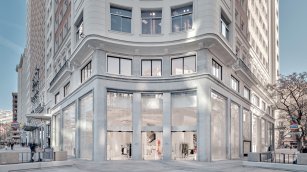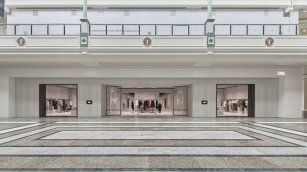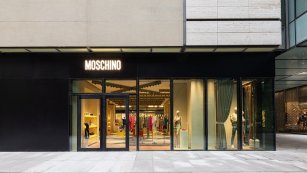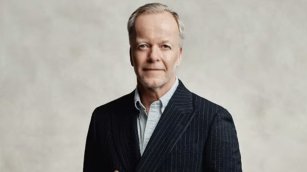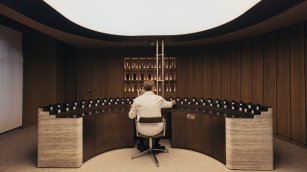Zara Turns 50: The Story Behind Inditex’s Fashion Revolution
As Zara celebrates its 50th anniversary since Amancio Ortega opened the first store of Inditex’s flagship brand, how did it manage to reinvent fashion? Zara created a model that no one, not even Inditex, has been able to replicate.

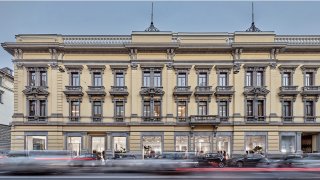
Today, May 9, Zara celebrates the fiftieth anniversary of the opening of its first store, on Juan Flórez street in A Coruña. The National Highway 6, formerly called N-VI and today N-6 and, above all, the road to La Coruña, links Madrid with A Coruña, passing through municipalities such as Lugo, Ponferrada, Astorga, Tordesillas, Guadarrama, Collado Villalba and Las Rozas. This was the route followed by Amancio Ortega when, in the 1980s, he decided to begin the expansion of a concept that would end up revolutionizing the global fashion industry: Zara.
With the store as the nerve center, Inditex obtained real-time information to create fashion adapted to consumer tastes, at low prices and, above all, fast, which has ended up giving rise to a Spanish model in the fashion industry but which, deep down, no one, not even Inditex itself, has managed to repeat. Fifty years after Amancio Ortega opened the first Inditex flagship store, how did Zara manage to reinvent fashion?
"One store has a fake French accent and the other a real Spanish accent, but both speak the same language of fashion. It's a language understood by young fashion followers on a limited budget who nevertheless change their clothes as often as the color of their lipstick." So began the article that journalist Anne-Marie Schiro published in The New York Times on December 31, 1989, on the occasion of the opening of an Express and a Zara store on Lexington Avenue in New York.
In that article, titled Two new stores that cruise fashion's fast lane, the term fast fashion, an expression that describes a business model, was used for the first time , filling headlines, reports and academic papers. While Express ended up being rescued from the courts last summer, the second, Zara, has given rise to the world's largest fashion retail group and has ended up changing the history of the sector.
The Lexington Avenue store was, in fact, the first Zara store outside the Iberian Peninsula, but to get there Inditex, when it was not even Inditex, had to lay the foundations of its model, perfected over the years but whose pillars remain firm.
Amancio Ortega and Rosalía Mera, together with the brothers of the former, decided to go into business in textile production.
Busdongo de Armas, in León, currently has 72 inhabitants, according to the Town Council of Villamanín, to which it belongs. Amancio Ortega Gaona was born in this town in March 1936, only four months before the beginning of the Civil War. The history of Busdongo was marked by the railroad, just like Ortega's origins. His father, a native of Valladolid, worked there as a railwayman and when little Amancio was only three months old he was transferred to Tolosa (Guipúzcoa), where the family, with two older children, Antonio and Josefa, lived for about ten years, when they moved, again following the train, to Galicia.
In his teens, Amancio Ortega left school and entered the world of work to alleviate the family's economic hardship, working as a deliveryman in the Gala shirt shop in A Coruña, with high-born customers in the city and that would end up closing its doors in 2015, victim, like so many other stores, of the transformation of fashion distribution.
From Gala, Amancio Ortega moved on to another classic store in the city, La Maja, where his first wife, Rosalía Mera, a Coruña native of humble origins who started as a seamstress and later became a sales clerk, also worked.
Amancio Ortega and Rosalía Mera, together with the brothers of the former, decided to start a business in textile production and, after some tests that did not work out well with other products, they came up with what would be the origin of an empire: wadding robes. In a first floor of A Coruña and made by Mera and the wife of Antonio, Amancio's brother, the gowns began to be marketed in the early sixties.
In 1989, on the occasion of the opening of Zara in New York, 'The New York Times' published an article that used the term 'fast fashion' for the first time.
In 1963, when Spain continued to open up to the outside world in the midst of Franco's dictatorship and the arrival of the "yeyé" fashion, to the sound of The Beatles' first LP, GOA was founded, an acronym of the backwards initials of Amancio Ortega's name. The small workshop began its steps first as a manufacturer and then as a wholesaler, when GOA labels in oriental typography began to appear sewn to the garments that were exported to several European countries.
As a wholesale distributor, Amancio Ortega realized two things that would mark his career: margin and risk. It was the 1970s and the world was in the throes of the oil crisis, which began in late 1973 after the Organization of Petroleum Exporting Countries (OPEC) decided not to export any more oil to countries that had supported Israel during the Yom Kippur War.
In that decade, specifically in 1974, the Multifiber Agreement was also signed, which regulated global trade in textile products and established, as of January 1, 2005, the total liberalization of the sector and the explosion of fashion as a global industry.
The cancellation of an order by a German buyer and the crisis made the entrepreneur, now one of the richest men in the world, look for a business model that would allow him to be more flexible, on the one hand, and to dispose of the accumulated stock, on the other. If he had control of design and production, but not of the margin, why not skip the distributor and keep one hundred percent, so that he could be faster and more flexible? That must have been what Amancio Ortega thought when, in the mid-1970s, he opened his first store of his own.

Ortega's first store, however, did not work: it was called Sprint, it was on Torreiro street in A Coruña and he distributed different brands, such as On the Road. In 1975 would come the key moment with the opening of the first Zara store on Juan Flórez street in the Galician city, already with some original labels with the claim Zara. Tiendas de Moda, a sign with large red letters and shop windows that anticipated Amancio Ortega's vision of a common and global image.
Positioned since its foundation as a store in which to buy fashion garments of average quality at affordable prices (demonstrating the much-quoted democratization of fashion), the Juan Flórez store would be followed by another in the As Conchiñas Market.
Every weekend Amancio Ortega was in the store, talking to the saleswomen and customers," explains a former Inditex executive; " that was the original fast fashion, the magic came when it was scaled up. By the end of the seventies there were already a dozen Zara stores in different Galician cities, although GOA was still working as a wholesaler.
In the 1980s, Zara began its expansion in Spain following the N-6 and stores were opened in Ponferrada, León and Logroño. After its debut in Galicia, Zara's second trial by fire in Spain would come in Barcelona in 1983: if the chain worked in the Catalan capital, it would do so in the rest of the country. And it did. Led by a Galician couple living in Barcelona, Zara opened on Pelayo Street. In 1985 it arrived in Madrid, first on Bravo Murillo and then on Carretas Street.
By the end of the decade, Zara already had stores in all Spanish cities with more than 100,000 inhabitants. The country, which had just emerged from the dictatorship, was evolving by leaps and bounds and people were leaving the villages to settle in the city, leaving behind work in the fields to get to the office, progressing socially and buying apartments, cars and, of course, clothes.
And, from Spain, to the world. Unlike many other brands, which have waited to have a developed structure in their country of origin before making the international leap, Zara was daring in its expansion abroad. In December 1988, it opened its first store outside Spain in Oporto. A year later it landed in New York, with a store on Lexington Avenue, and in 1990 it did so in the fashion capital, Paris.
In 1985, five key events took place in the history of Inditex: the signing of Castellano, the abandonment of wholesale, the dedication of GOA's factories only to Zara, the creation of Inditex as an entity and consultancy in the automotive sector, and the creation of a new company in the automotive sector.
The first computer and 'just in time
In 1976 Amancio Ortega bought his first computer, as professors José Luis Nueno and Pankaj Guemawat recounted in 2001 in Zara: fast fashion, the first case written at the Iese business school about the fashion company. Goa then had four factories and only two stores, but the information it obtained from the latter already showed that the orders it served to third parties were different from those of other manufacturers. " Ortega's interest in information technology led him to contact José María Castellano, who had a doctorate in economics and professional experience in information technology, sales and finance," says the case.
In 1985, when Spain signed its Accession Treaty to the European Economic Community (to join it a year later), Castellano joined Amancio Ortega's team. This signing was crucial in the future of the company (Castellano led the company's IPO in 2001) and took place the same year in which other key events occurred: the abandonment of wholesale, the dedication of GOA factories only to Zara, the creation of Inditex as an entity and the grouping of all companies under it, and the arrival of a consulting team from the automotive sector.
Inditex's twenty or so factories, concentrated in A Coruña but also in Barcelona, were highly automated, specialized by product type and focused on the capital-intensive parts of the process (pattern-making and cutting), as well as on finishing and quality control.
Vertical integration had begun in 1980, but from 1990 onwards the introduction in the factories, in cooperation with Toyota, of a just-in-time model, the name given by Kiichiro Toyoda, founder of Toyota, to the system that seeks to produce only what is necessary according to market demand in order to improve efficiency and reduce costs by eliminating surplus, intensified.
In collaboration with Toyota, in the late 1980s Inditex introduced a 'just in time' system in its factories.
"When you sell through distributors you know the sell in," says Javier Vello, partner in charge of EY Transforma and EY's business consulting practice; " controlling all the information in the store changes everything. According to the consultant, controlling the data throughout the entire chain allows for better planning and adjusting production to the market as much as possible, as Inditex has shown in complex moments such as the Covid-19 crisis, when its supply costs advanced, at all times, at the same pace as the damaged sales.
Amancio Ortega's initial bet was an evolution of the Italian pronto moda. While pronto moda was made up of small manufacturers that quickly replicated fashion trends, specialized in different types of garments and without creating collections to then sell to wholesalers, Amancio Ortega evolved this system through the store, obtaining real-time information on what the consumer wanted and gaining speed, all supported by logistics and IT systems.
"In Italy you can find some similarities with fast fashion, but it was not fast - says Stefania Saviolo, professor at the Italian Bocconi University - the difference between the two is in the way of working, both in production and logistics: Inditex involves the entire supply chain, with all its agents, with a system that is completely vertical and integrated." "Zara invented its own production model," he exclaims.
Inditex puts the store at the center and logistics at its service, making everything work like a perfectly oiled machine," Vello says. "You have all the information under control and you build backwards, through what the store sells, reducing the time to market and gaining reaction time.

Other models
When Zara opened its first store, fashion was very different. In Spain, fashion was distributed in El Corte Inglés, Galerías Preciados, Sears, Sepu or Almacenes Arias, of which only one remains, El Corte Inglés, as was and has been the case in most countries in the world. The development of the chains, with Zara at the head, has led to a reorganization of fashion distribution channels and, with it, a redistribution of market shares because whoever controls the channel controls the sale.
At the time when Inditex began to be followed by stock market analysts, they considered that, although it competed with local operators in most markets, its most comparable rivals were the U.S.-based Gap, Sweden's H&M and Italy's Benetton. " All three had a smaller vertical scope than Zara, which owned a large part of its production and most of its stores," Iese's first case study on Inditex recounted.
In the early 2000s, Gap was the world's largest fashion retail group, followed by H&M. Headquartered in San Francisco, the former began its development in 1969 and, like Zara, sought to provide the market with comfortable and unpretentious clothing, adapting to American demand.
The store was also at the Gap's center, but its supply chain was totally outsourced and its response to the market was not quick. Since Gap had the United States as its home market, it did not need to go outside, and when it did (especially after the Great Recession) its casual fashion could not compete with the trend to which Zara had accustomed consumers.
In the late nineties Gap began to suffer even in the United States and, under Millard Drexler (CEO), tried to get closer to Zara's model by introducing more fashion and speed, but did not succeed. Gap is still in crisis today and is trying its umpteenth relaunch, this time with branding as a fundamental piece with Richard Dickson (ex-Mattel) at the helm.
When Inditex started trading, analysts considered that its competition was the American Gap, the Swedish H&M and the Italian Benetton.
H&M's history is even older. In 1947, Erling Persson opened his first store after a trip to New York, having been impressed by the American distribution model, which was capable of moving large volumes of merchandise, with examples such as Macy's. Volume rather than speed was therefore at the origin of H&M, which outsources all its production, especially to distant countries, with Bangladesh among the most prominent.
With Sweden as its local market, H&M's internationalization came early, although, as has happened to Gap, its offer (starring basics produced in volume and remotely) has not been able to compete with that of Zara. The Swedish group is also in the process of redefining itself and, like Gap, is now trying to gain speed by playing fast fashion.
Of the big groups of two decades ago, the one that has fared the worst is Benetton, founded in 1965. Benetton, unlike Gap and H&M, had invested in production structure, but its stores were managed by franchisees, with whom it expanded around the world.
Without the information of what was happening in the store because it was in the hands of third parties, Benetton was disconnected from the market and did not know how to adapt to the changing habits of consumers, for whom the flashy advertising campaigns of the eighties and nineties and its bright colors were no longer differential. At the end of the nineties, Benetton's business began to languish, a crisis that continues to this day.
Fast Retailing, with Uniqlo at the head, or Primark are other giants that have emerged in recent decades, none with the same model as Zara. While the Irish chain Primark outsources its production, betting on maximum volumes to offer the lowest possible prices, the latter could have a model more similar to Zara's, although without speed. Uniqlo has a close relationship with its suppliers, thanks to which it manages to adjust the prices of high quality basics that it distributes in its own stores. Both have stores, but neither is fast.
Unlike Zara, Gap and H&M outsourced all their production; Benetton, on the other hand, had its own production, but grew through franchising.
In Spain, Mango is currently the second largest group in the sector, behind Inditex. The company founded by Isak Andic (who died last December) is committed to the physical store as a distribution channel, although in its development it combines its own stores with franchises.
In its structure, the lower costs of remote production play a fundamental role, so that it cannot have the speed of Zara. At times in its history, Mango has also tried to play fast fashion, but has not succeeded.
"Mango tried to be Zara, Blanco tried to be Zara or Gap, with Drexler, tried to be Zara, but it was not flexible enough," says Luis Lara, consultant and advisor and former executive of companies like Inditex . Not even Inditex has managed to do so with the other chains it has launched or bought over the years.
"At Inditex, all the pieces are grouped around a very peculiar culture, in which the store is the most important thing," adds Lara, who points out that the store, key locations, sourcing model, logistics and data are the elements that define Zara's business model.
"Zara has mastered the short times: it has more sourcing, but at less cost, which results in less gross margin, but more full price," says another industry expert. Amancio Ortega, Bernard Arnault (LVMH) and now Shein represent three different business models of success and innovation, but no one else has made a second Zara," he says. "We could expect other brands to try, but it is difficult for two reasons: it is very difficult to do what they do and, if they already exist, it is very difficult to adapt a business model to something similar. No one has managed to replicate the model, but it has influenced the entire industry.

The cocktail shaker
What elements did Zara put in the shaker in its early days that have made it reinvent fashion? "Zara completed its deployment in the Spanish market in the 1990s and began expanding abroad at the same time," explained Professor José Luis Nueno in the early 2000s, "and also began making major investments in logistics, manufacturing and IT, including the establishment of a just-in-time manufacturing system, a 130,000 square meter warehouse near the corporate headquarters in Arteixo, just outside A Coruña, and an advanced telecommunications system to connect the headquarters and the supply, production and sales centers.
All this resulted in a model that, in essence, is still in place today. The company maintains part of the production structure as its own (although over the years it has lost verticalization with the closure of factories and outsourcing) and combines short and long series and distance and proximity in its supply, having the capacity to adapt to market demand and emerging trends, in addition to the information it now receives not only from its stores but also from the Internet.
All production, internal and external (with satellite suppliers that supply fresh product), was and is centralized in its own logistics centers, initially located in Galicia, then in Spain and, in recent years, also in other countries such as the Netherlands or the USA to gain the speed required by online orders.
"With its production model, Zara broke with the traditional two seasons; it found itself in functionality through drops appealing to consumers' clothing needs," says Massimiliano Giornetti, director of the Polimoda school and former creative director of Salvatore Ferragamo. "Zara not only manages to understand the needs of its consumer, but is able to fulfill them and has risen as a brand," he adds; "few in its segment have managed to create an experience around the store and the product.
Zara's model, which is still fundamentally the same, was based on adapting production to demand, which was reached through the store, from which the store's information was obtained.
The vertical integration of Inditex's origins helped to reduce the bullwhip effect, a phenomenon of inaccuracy in the estimation of demand by each member of the supply chain when there are fluctuations in order volumes.
In addition, vertical integration allowed Zara to create a design and have finished products in stores within four to five weeks for entirely new designs, and two weeks for modifications (or replenishment) of existing products. "In contrast, the traditional industry model could involve cycles of up to six months for design and three months for manufacturing," the Iese case stated.
A perfectly oiled communications, logistics and sourcing structure but with the store as the origin and end point. "Zara reflects in its stores the freshness of its offerings, the creation of a sense of scarcity and an attractive atmosphere around them, and the resulting positive word of mouth," said Nueno two decades ago, when the penetration and awareness of the Inditex flagship was not as high as it is today.
"Fast turnover turned into turnover," he added, "inventories were tightly controlled even if it meant leaving demand unsatisfied.
Freshness was based on fast turnover, with new designs arriving in each biweekly shipment, and loyal buyers even knew what day the trucks delivered to stores. About three-quarters of the merchandise on display was changed every three to four weeks, the time that elapsed between shopper visits to the store, bearing in mind that the average Zara shopper was estimated to visit the chain 17 times a year (compared to an average of three to four times a year for its competitors).
The sense of scarcity was reinforced by small shipments to the store, a one-month limit on the time an item could be in store and, on certain occasions, a deliberately low volume of shipments.
The freshness of the offer and the constant renewal of the product caused in the early days of Zara's store network a feeling of scarcity that generated an increase in visits and purchases.
The role of store managers was fundamental in the origins of Inditex. In fact, according to José María Castellano, when he was CEO of the company, the availability of store managers capable of carrying out all the functions required by Zara was the main brake on the pace of openings.
These managers not only supervised all the staff and managed the store, but also decided what merchandise to order or discontinue and passed on consumer information to the design teams, with qualitative details that the sales records did not capture.
The stores, beautiful inside and out, helped make store visits more frequent, as did their location, always in prime areas (whether on the street or in shopping malls), and the window displays. The interior design and the shop windows, with image and changes (according to the rhythm of the season) totally centralized and directed from Arteixo, served and serve Zara to boost its brand image.
Thus, the stores functioned for Zara not only as sources of information, but also as a communication tool. Zara's initial business model was based on a low investment in advertising, which could be around 0.3% of total turnover. Today, with the emergence of social networks and the need for continuous generation of content and impacts, these percentages have changed, although traditional media campaigns are still concentrated in the sales season.

New sector
When fashion, and not clothes, only reached the upper classes, Inditex invented a new model in which everyone could have access to a jacket with studs and buckles like those seen in fashion magazines. All this was done with perfect operations at the service of the product and the store, a system that introduced speed and competition in the sector.
With the speed of arrival to the market, Zara broke the seasons and, with them, touched (in some cases to death) all those brands that were governed by them and, above all, changed the distribution, leaving heavily wounded the multi-brand channel where, in turn, these brands were sold.
The fashion pyramid changed forever after the arrival of Zara and even more so today, at a time when the figurehead of Inditex is looking for a new positioning to take its model, climbing the rungs with collaborations, designers, photographers and, above all, a product and stores with little to envy to the highest brands.
When the brand, with a new generation of the Ortega family (with Marta, daughter of the founder, as president) at the helm, becomes more relevant, the key is to maintain the balance and keep the store at the center to ensure the survival of a culture that invented, once again, fashion.


